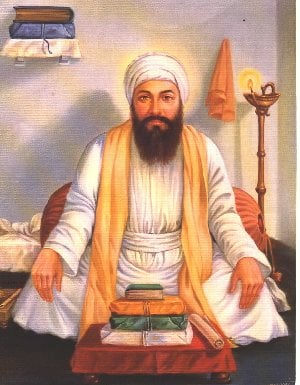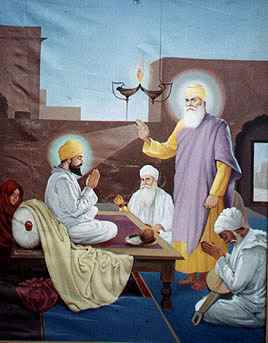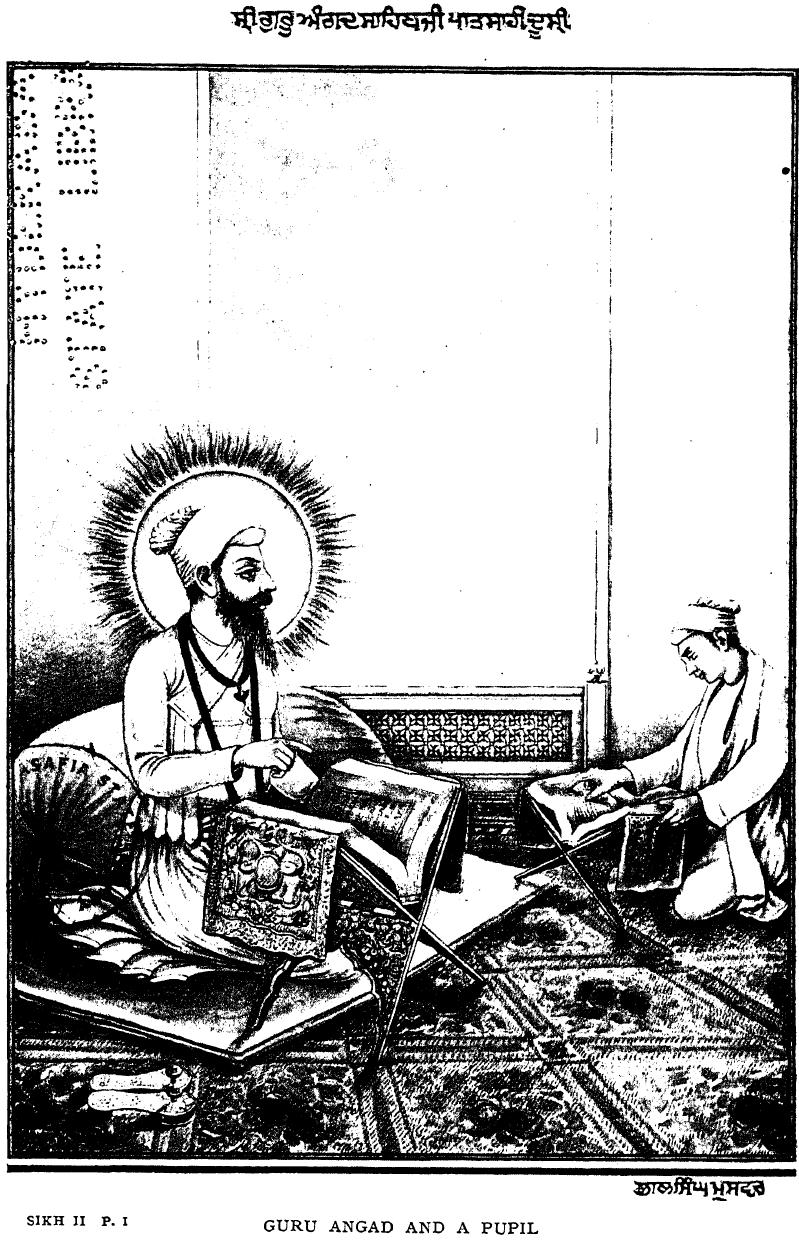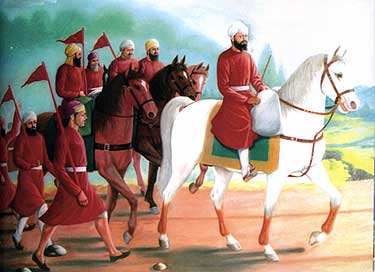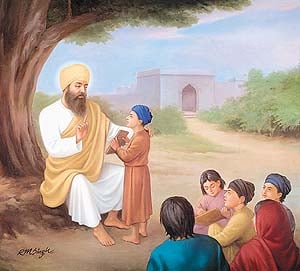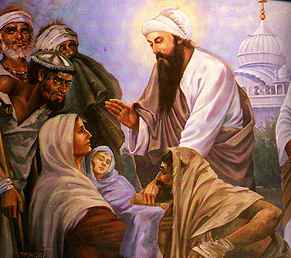Guru Angad Dev
"Air is the Guru, Water is the Father, and Earth is the Great Mother of all. Day and night are the two nurses, in whose lap all the world is at play. Good deeds and bad deeds-the record is read out in the Presence of the Lord of Dharma. According to their own actions, some are drawn closer, and some are driven farther away. Those who have meditated on the Naam, the Name of the Lord, and departed after having worked by the sweat of their brows - O Nanak, their faces are radiant in the Court of the Lord, and many are saved along with them! ||1||" - Guru Angad Dev Ji
| Guru Angad Dev (1539 to 1552) | |
| Full Name : | Bhai Lehna |
| Personal Details | |
| Birth : | Thursday March 31 1504, Matte Di Sarai (Sarainaga), Sri Muktsar Sahib, Punjab, India |
| Guruship : | Thursday September 18 1539 From age 35 for 13 years: 1539 to 1552 |
| Joti Jot : | Saturday April 16 1552 |
| Family | |
| Parents : | Bhai Pheru Mall & Mata Sabhrai |
| Brother/Sisters : | -N.A- |
| Spouse : | Mata Khivi |
| Children : | Sons - Baba Dasu Ji & Baba Dattu Ji, Daughters - Bibi Amro Ji & Bibi Anokhi Ji |
| Other Details | |
| Bani in GGS: | Total of 63 Shabads and Saloks |
| Other Info: | See also - Guru Angad's Bani |
Guru Angad Dev Ji (Gurmukhi: ਗੁਰੂ ਅੰਗਦ ਦੇਵ ਜੀ) (Thursday March 31, 1504 - Saturday April 16, 1552), Nanak II, was the second of the ten human form Gurus (divine messengers) of the Sikh faith.
Guru Ji was born with birth name Lehna in the year 1504 at Matte Di Sarai (Sarainaga) District Sri Muktsar Sahib of Punjab, India. To father Bhai Pheru Mall Ji and mother Mata Sabhrai Ji (also known Daya Kaur). Born in a Hindu family, Bhai Lehna Ji used to be a worshipper of the Hindu Goddess, Durga. At age 27, after hearing the recitation of hymns of Guru Nanak from Bhai Jodha (a Sikh of Guru Nanak Dev Ji ), Bhai Lehna Ji decided to travel to Kartarpur to meet the Guru. Having met Guru Nanak Dev Ji only once, Bhai Lehna Ji was transformed to such an extent that he decided to renounce his own faith and became a Sikh of Guru Nanak Dev Ji, devoting himself completely to Guru Nanak Dev Ji and his mission. His discipleship was subjected to various tests by Guru Nanak Dev Ji himself, following which he came to be renowned as an embodiment of obedience and service to the Guru and humanity. Before passing away, Guru Nanak Dev Ji renamed Bhai Lehna as Angad (from Ang, or one's own body part), and installed him as his successor, the second Nanak, on 13 June, 1539.
As the second Guru of Sikhs, some of the main highlights of Guru Angad Dev Ji’s life include:
- Contributed 63 Shabads and Saloks (revealed verses), now registered in the Guru Granth Sahib
- Through their own life conduct, Guru Ji demonstrated the principles of Nishkam Sewa (selfless service) to humanity, complete surrender to the Guru and to the will of God, and disapproval of exhibitionism and hypocrisy
- Formalized the present form of the Gurmukhi script
- Maintained and developed the institution of Langar started by Guru Nanak Dev Ji
- Traveled widely and established several new centers for preaching Sikhi
- Started the tradition of Mall Akhara to emphasize physical well being, to go along with spiritual development
Before Guru Angad Dev left for his heavenly abode in 1552, He nominated Guru Amar Das Ji as the third Guru of the Sikhs.
Invention of Gurmukhi
Guru Angad Dev ji invented the present form of the Gurmukhi script. It became the medium of writing the Punjabi language in which the hymns of the Gurus are expressed. This step had a far-reaching purpose and impact. Firstly, it gave the common people a language that is simple to learn and write. Secondly, it helped the community to dissociate itself from the very reserved and complex nature of the Sanskrit religious tradition so that the growth and development of the Sikhs could take place unhampered and unprejudiced by the backlog of the earlier religious and social philosophies and practices.
Earlier, the Punjabi language was written in the Landa or Mahajani script This had no vowel sounds, which had to be imagined or construed by the reader in order to decipher the writing. Therefore, there was the need of a script which could faithfully reproduce the hymns of the Gurus so that the true meaning and message of the Gurus could not be misconstrued and misinterpreted by each reader to suit his own purpose and prejudices. The devising of the Gurmukhi script was an essential step in order to maintain the purity of the doctrine and exclude all possibility of misunderstanding and misconstruction by any person.
Further establishment of Langar
The institution of Langar was maintained and developed. The Guru's wife, Mata Khivi personally worked in the kitchen. She also served food to the members of the community and the visitors. Her devotion to this institution finds mention in Guru Granth Sahib.
The Guru earned his own living by twisting coarse grass into strings used for cots. All offerings went to the common community fund. This demonstrates that it is necessary and honourable to do even the meanest productive work. It also emphasises that parasitical living is not in consonance with the mystic and moral path. In line with Guru Nanak's teaching, the Guru also declared that there was no place for passive recluses in the community.
Details
Guru Angad Dev, (Bhai Lehna ji) was born in the village Matte Di Sarai (Sarainaga) District Sri Muktsar Sahib of Punjab, on Vaisakh Vadi 1st , (5th Vaisakh) Samvat 1561, (March 31, 1504). He was the son of a sucessful trader named Bhai Pheru Mall usually referred to as Bhai Pheru. His mother 's name was Mata Ramo ji (also known as Mata Sabhirai, Mansa Devi, Daya kaur). Baba Narayan Das Trehan was his grand father, whose ancestral house was in Matte-di-Sarai (Sarainaga) District Sri Muktsar Sahib. Pheru ji moved back to this place.
Under the influence of his mother, Mata Ramo, Bhai Lehna ji began to worship Durga (A Hindu mythological Goddess). He used to lead a batch of worshippers to Jawalamukhi Temple every year. He was married to Mata Khivi ji in Jaunary 1520 and had two sons (Bhai Dasu and Bhai Datu) and two daughters (Bibi Amro and Bibi Anokhi). The whole family of Bhai Pheru had to leave their ancestral village because of the ransacking by the Mughal and Baloch militia who had come with Babur. After this the family settelled at village Khadur Sahib beside the Beas river, near Tarn Taran Sahib (A small town about 25 km. away from Amritsar City).
Once Bhai Lehna ji heard the recitation of a hymn of Guru Nanak Sahib from Bhai Jodha (a sikh of Guru Nanak Sahib) and was thrilled and decided to proceed through Kartarpur to have a glimpse of Guru Nanak Sahib at the time of yearly pilgrimage to Jwalamukhi Temple. His very first meeting with Guru Nanak Sahib completely transformed him. He renounced the worship of Hindu Goddess, dedicated himself to the service of Guru Nanak and became his Sikh (disciple), and began to live at Kartarpur. His devotion to Guru Nanak and his holy mission was so great that he was installed as the Second Nanak in September 7, 1539 by Guru Nanak himself. Earlier Guru Nanak tested him in various ways and found an embodiment of obedience and service in him. Guru Nanak gave him a new name "Angad" (Guru Angad Sahib). He spent six or seven years in the service of Guru Nanak Sahib at Kartarpur.
After the death of Guru Nanak Sahib on September 22, 1539, Guru Angad Sahib left Kartarpur for Khadur Sahib Village (near Goindwal Sahib). He carried forward the thought of Guru Nanak Sahib both in letter and spirit. Yogis and Saints of different sects visited him and held detailed discussions about Sikhism and Dharam with him .
Guru Angad Sahib introduced a new alphabet known as Gurmukhi script, modifying the old Punjabi script's characters. Very soon, it become the script of the masses. He took great interest in the education of the children by opening many schools for their education and thus increased the number of literates. For the youth he started the tradition of Mall Akhara, where physical as well as spiritual exercises were held. He collected the facts about Guru Nanak Sahib's life from Bhai Bala ji and wrote the first biography of Guru Nanak Sahib. (Bhai Bale Wali Janamsakhi available now a days in not the same as the one that Guru Angad Sahib had compiled.) He also wrote 63 Saloks (stanzas), which were later included in Guru Granth Sahib by the fifth Sikh Guru, Guru Arjan. He popularized and expanded the institution of 'Guru ka Langar' that had been started by Guru Nanak.
Guru Angad Dev visited all important places and centres established by Guru Nanak for preaching Sikhism. He also established hundreds of new "Dharamsalas" (Sikh religious Institutions) and thus strengthened the base of Sikhism. The period of his Guruship was the most crucial one. The Sikh community being in infancy, had to face many dangers. It was not difficult for Hinduism to swallow the newly born Sikhism in due course of time. Moreover Sri Chand's Udasis sect community and the activities of Jogies had not yet abated. At this hour of juncture he lived Guru Nanak Sahib's tenets in true spirit and there were manifest signs of establishing a distinct "way of life" away from Hinduism. Sikhism became to established its own separate religious identity.
Guru Angad Dev, by following the example of Guru Nanak, nominated Amar Das as his successor (The Third Nanak) before his death. He presented all the holy scripts including those he received from Guru Nanak, to Guru Amar Das. He breathed his last on March 29, 1552 at the age of forty-eight. It is said that he started to build a new town, at Goindwal near Khadur Sahib and Guru Amar Das was appointed to supervise its construction. It is also said that Mughal emperor, Humayun, when defeated by Sher Shah Suri, came to obtain blessings of Guru Angad Dev in regaining the throne of Delhi.
With compliments to www.sgpc.net for the above account.
Guru Angad Dev Ji's Contributions
This is the nature of ego, that people perform their actions in ego. This is the bondage of ego, that time and time again, makes people suffer”
Eliminate your conceit and then perform service to humanity,
Only then you will be get honor - Guru Angad Dev Ji
On April 18, 2007, the Sikhs marked the 503rd Birth anniversary of Guru Angad Dev, the second Guru in Sikhism. The appointment of Guru Angad Dev by Guru Nanak Dev ji, the founder of Sikhism, as his own successor was an event of far reaching significance in the evolution of Sikhism. The second Guru, who believed to have embodied the spirit of his great predecessor, consolidated the infant faith movement through his energy and his global vision.
On this auspicious occasion, let us remind ourselves of the simple and sublime teachings of Guru Angad Dev, which are non-sectarian and universal in their application. Guru Angad Dev is one of the world teachers whose message is of universal application and is valid for all time. It has particular relevance not only to us but to the whole of mankind at this critical period of human history, If only we pay heed to it, we can surely foster universal brotherhood based on mutual love, respect and understanding, and we can build and promote international peace.
Gurmukhi Script and Education
Guru Angad Dev ji started the schools and also developed the Gurmukhi language in order to make education available to the downtrodden and the underprivileged of the society at that time. Guru Angad Dev was a great teacher who personally taught Punjabi in Gurmukhi script to children. He provided education and means of communication to common folk who would no longer be dependent on the religious or political establishment to pursue their own economic, educational or spiritual goals. This was his way of empowering people to have higher goals in life.
An imperfect Punjabi alphabet existed at the time of Guru Nanak, but Guru Angad Dev modified and polished it. Since the Guru Angad Dev had adopted the modified alphabet, it was called 'Gurmukhi'- meaning that which is spoken through the mouth of the Guru. Gurumukhi became the medium of writing in which the hymns of the Gurus were expressed and it also suited to the language of the people. Although the origins of the Punjabi Alphabets are unclear, it is clear that Guru Angad Dev popularized the use of this simplified Gurumukhi script among the Sikhs starting around 1541.
The invention of Gurumukhi helped the early Sikh community to dissociate itself from the Sanskrit religious tradition. Sanskrit language was used by the Brahmins, the upper castes and it was the language of the Vedas, the Hindu religious texts. People of lower castes and untouchables were barred from reading any spiritual literature. This maintained the status of the superiority of the upper castes. Gurmukhi enabled the Sikhs to grow and develop their own unprejudiced spiritual literature. Creating this new script was significant for many reasons. It gave the people who spoke this language an identity of their own, enabling them to express their thought without any restrictions. The guru also saw the need of a script which could faithfully reproduce the hymns of the Gurus keeping its purity and which would also prevent misinterpretation or misconstruction by any reader to suit his own purpose and prejudices.
This step by Guru Angad Dev helped secure the unhindered development and growth of Sikhism. Guru Angad Dev also initiated the writing of the first authorized biography of Guru Nanak completed in 1544, as well as having a number of copies of Guru Nanak's hymns written out in the new Gurmukhi script.
Physical Fitness
Guru Angad Dev ji took a keen interest in physical fitness, and encouraged his devotees to be involved in sports after their morning prayers. Guru Angad Dev inspired people to lead healthy lives. According to Guru ji, if you are physically fit only than you can pursue higher goals in life, because a sound mind can exist only in a sound body. He provided opportunities to underprivileged sections of the society to maintain good health. He encouraged all people to be involved in wrestling bouts or Mal Akharas to compete in physical competitions. This was again his way of doing away with social taboos of people of lower caste not having physical contact with higher castes. These steps initiated by him laid the foundation for a spiritually, educated and enlightened, healthy Sikh community, without distinctions of caste and creed.
Women’s role
The position of woman at the time was deplorable. She was looked down upon because she was thought to be inferior to man and was regarded as merely a temptress. She was confined to her home and was not allowed to participate in any public work. Guru preached that man and women were equal before God. He welcomed women to the Sangat, offered them seats side by side and gave them religious rights that have so far been denied to her.
Guru Angad Dev scarcely worked alone. His wife and partner, Mata Khivi, is a very important woman who contributed significantly to Sikhism. Mata Kheevi played a major role in enlarging the women participation in the leadership position in Guru’s court. Mata Khivi was instrumental in creating and maintaining the institution of langar, whereby all devotees of the Guru and all people in general, were invited to come and eat together. This practice started initially with Mata Khivi serving food to the members of the community and the visitors who would come to see Guru Angad Dev and it came to symbolize the Guru’s teachings; emphasizing the humanity in every single person and abolishing any innate discriminations. She did her job in a skillful and selfless manner, characteristic of her, and evoked spontaneous respect among the people. Her role in that capacity was unique and revolutionary because women were usually not seen in the forefront of the society. She also made sure that the food being fed was nutritious and wholesome because many who came to see Guru were needy and destitute. Mata Kheevi would embrace them all and offer love and food. She was, to use the simile of the contemporary ministrel Balwand, like a shady tree to the Guru’s disciples and afforded them effectual shade. Her role and praise is recorded in the Guru Granth Sahib.
To this day, after every service, visitors to a Sikh gurudwara witness a congregation who join and eat Langar together. Langar also emphasized that service to fellow man was an important tenet of the Sikh way of life, as it is customary for members of the congregation to serve one another.
Guru Angad Dev Ji’s Message:
Equality
Guru Angad Dev ji stood for a casteless and classless society, in which no one was superior to the other and no one, through greed or selfishness, could be allowed to encroach upon the rights of others. In short, he visualized a society in which members lived like a family, helping and supporting one another. He not only preached equality but practiced it. To promote the acceptance of human equality, Guru established a community kitchen where all sat together in a row, regardless of caste or status, and ate the same food.
Guru Angad Dev said, “He Himself creates, O Nanak; He establishes the various creatures. How can anyone be called bad?. There is One Lord and Master of all; He watches over all, and assigns all to their tasks. Some have less, and some have more; no one is allowed to leave empty.” – Guru Angad Dev Ji
Furthermore, the guru stressed the importance of adopting a uniform way of praising God and the utility of a social organization based on equality. He established a holy congregation, or Sangat, where people of different beliefs and varying social status sat together to hear the Master’s singing of hymns and to be inspired to lead a noble life.
Devotion and Love towards God
Guru stressed the oneness of God. The purpose of life is to seek God, find him and be united to Him. He called upon the people to give up formal and superficial rituals and rally around the Creator, who alone was Omnipotent and Omnipresent. According to Guru Angad Dev, no one has ever found acceptance or achieved self-realization without true devotion to God.
“ O Nanak, if someone judges himself, only then is he known as a real judge. If someone understands both the disease and the medicine, only then is he a wise physician. Do not involve yourself in idle business on the way; remember that you are only a guest here.”
Good deeds are important but winning God’s Grace is still more important. Pride, greed and ego are the greatest distractions to keep away humans from the Creator. A guru or a spiritual divine teacher is needed to guide the man on the true path.
“That virtuous person who does not walk in the way of greed, and who abides in Truth, is accepted and embraced by God”.
This is the nature of ego, that people perform their actions in ego. This is the bondage of ego, that time and time again, makes people suffer”
Guru Angad Dev also emphasized that one must control the greed and worldly attachment because they are impediments in the path of God. One must stay focused on the inner development.
“They know that they will have to depart, so why do they make such ostentatious displays? Those who do not know that they will have to depart, continue to arrange their affairs. He accumulates wealth during the night of his life, but in the morning, he must depart. O Nanak, it shall not go along with him, and so he regrets.”
“The mouth is not satisfied by speaking, and the ears are not satisfied by hearing. The eyes are not satisfied by seeing—each organ seeks out one sensory quality. The hunger of the hungry is not appeased; by mere words, hunger is not relieved. O Nanak, hunger is relieved only when one utters the Glorious Praises of the Praiseworthy Lord.”
Fearlessness
He was a constructive architect of a society which focused on the social and religious freedom and equality, promoting dignity of action without distinction of caste and status. He was born at a time when ritual, caste distinctions and superstition had reduced the people to a low level of existence. He gave them courage and uplifted them. He taught the people to lead a righteous life and show due reverence and respect to God instead of supplicating before men. By his own example he made the people fearless and put a new life and spirit in them.
“Those who have the Fear of God, have no other fears; those who do not have the Fear of God, are very afraid. O Nanak, this mystery is revealed at the Court of the Lord.”
The Guru also extolled the dignity of labor and decried the division of society on grounds of birth and founded a classless society based on the idea of equality and universal brotherhood.
He was particularly aware of the degradation which the lower classes of the people suffered through centuries at the hands of rulers and the so called high caste people. He aligned himself with the down-trodden and the less fortunate sections of the people and preferred to stay with the working class people.
Company of the Holy
Guru Angad Dev confirms that “those who meditate on the Eternal Lord, who is fearless and is All Pervasive, are not only themselves emancipated, but they rescue many others form this net of illusion.”
Sewa
Guru Angad Dev Ji believed in the service and well-being of all mankind and not just of his own followers. He laid stress on character building rather than observance of rituals and formalities. The path which Guru Angad Dev pointed out to his Sikhs for achieving enlightenment was through service and good actions and devotion and worship of one God. He asked his followers to win Divine grace by prayer, singing His praises, cultivating humility, a spirit of service and submitting at all time to His will. Paying a fine under pressure, does not bring either merit or goodness. That alone is a good deed, O Nanak, which is done by one’s own free will. Sewa has to be done selflessly.
Eliminate your conceit and then perform service to humanity, Only then you will be get honor - Guru Angad Dev Ji
Divinity Within
He stressed the importance of the physical body as an instrument of spiritual development. He told his followers that there was a spark of divinity in every human being. The body is the temple of God as it houses the soul. God’s presence can be felt by deeper contemplation and reflection within.
“Twenty-four hours a day one looks for contentment in eight different directions but one must also explore the ninth place, which is to their own body and contemplate within. Within the body are the nine treasures of the Name of the Lord—seek the depths of these virtues. Those blessed with the karma of good actions praise the Lord and become true devotees” – Guru Angad Dev Ji
“Those who are blessed with the glorious greatness of Your Name — their minds are imbued with Your Love. O Nanak, there is only One Ambrosial Nectar; there is no other nectar at all. O Nanak, the Ambrosial Nectar is obtained within the mind, by Guru’s Grace.”
Life of Action
He held firmly that physical austerity was not necessary and that spiritual development was not dependent on ritual and external wanderings. “austerity and everything come through immersing oneself in the meditation of the Lord’s Name. All other actions are useless. O Nanak, believe in the One who is worth believing in. By Guru’s Grace, he is realized.”
Guru Angad Dev was at once a spiritual teacher and a man of action. To Guru Angad Dev, religion was not only a spiritual experience but a way of life. Every action must have an impact of spirituality, humility and love. This can be achieved if one is always conscious of the presence of God. Guru Angad Dev insisted that there should be harmony between thought and action and purity in life. “Doing some thing unwillingly or doing under pressure from someone, does not bring either merit or goodness. That alone is a good deed, O Nanak, which is done by one’s own free will.”
“Mortals are known by their actions; this is the way it has to be. They should show goodness, and not be deformed by their actions; this is how they are called beautiful. Whatever they desire, they shall receive; O Nanak, they become the very image of God.” -Guru Angad Dev Ji
“O Nanak, the worldly achievements and glory is worthy of being burnt in the fire if it causes one to forget God. Usually these worldly things has caused mortals to forget the the Name of the Lord. Not even one of them will go along with you in the end.” - Guru Angad Dev Ji
Gurdwaras connected with Guru Angad Dev Ji:
These following are famous historical Gurdwaras connected with Guru Angad Dev Ji:
- 1. Gurudwara Mai Bhrayi: Mai Bhrayi was Guru Ji's paternal aunt. When the Guru moved to Kartarpur from Khadur Sahib on Guru Nanak's behest, this is where he stayed and worshipped in solitude.
- 2. Gurudwara Darbar Sri Guru Angad Dev Ji, Khandi Sahib: Guru Ji would gather his followers here and disseminate his teachings.
- 3. Gurudwara Tapiana Sahib: After the religious gatherings, Guru Ji used to chant and worship here.
- 4. Gurudwara Mal Akhara: This was the arena for exercising.
- 5. Gurudwara Matte Di Sarai (Sarainaga): This is Guru Angad Dev Ji's Place of Birth.
- 6. Gurdwara Khadur Sahib, Dist. Amritsar
Also See
External Links
- DiscoverSikhism - Sri Guru Angad Dev Ji Sri Guru Angad Dev Ji is second of the Ten Sikh Gurus. Read about his life and stories here.
- Guru Angad Dev Ji - Nanak Bhagti
- Guru Angad Dev's Website
- Detailed Account
- Sikh Missionary Society
- www.sgpc.net
- Gateway to Sikhism
- Sikh Missionary Center
- www.sikhpoint.com/
- www.ikonkar.com
- Guru Angad Dev Ji's Contributions and His Message
| Relatives of Guru Angad Dev |
|
Bhai Pheru Mall ӝ Mata Sabhrai ӝ Mata Khivi ӝ Baba Dasu ӝ Baba Dattu ӝ Bibi Amro ӝ Bibi Anokhi ӝ Karan Devi ӝ Bhai Devi Chand ӝ Bhai Gchnu Mall |
| Preceded by: Guru Nanak (Founder of Sikhism) |
Guru Angad Dev | Followed by: Guru Amar Das (Third Sikh Guru) |
| These are the Ten Gurus of Sikhism |
|
Guru Nanak | Guru Angad Dev | Guru Amar Das | Guru Ram Das | Guru Arjan | Guru Hargobind | Guru Har Rai | Guru Har Krishan | Guru Teg Bahadur | Guru Gobind Singh |
